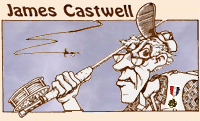|
There are two times a year to tie flies. The night before you go fishing and when, due to
some uncontrollable set of circumstances, you can not go fishing. I am not going fishing
tomorrow; nor anytime in the near future. So, therefore, it is time for me to tie flies.
When I tie flies at this time of year it is different though. In the first situation I am full of
planning and anticipation of the next day and all it may bring. The flies are ground out with
dispatch and sometimes fished with the sneaking suspicion the head cement may not be
all together dry. But, not so at this time of year, this is magic time. Time for dreams,
speculation, experimentation, memories, the taking of one's time, the stuff fly-tying is made
of. I want to pass along some of the things I mutter about, agonize over, and in general, let
cloud my already shaky judgement on how to tie a decent fly.
I won't go into nymphs, I have tied them and fished them. I also will not go into emergers
either; same reason. Streamers can be fun, but they are not insects and mostly I consider
them in a special class. That leaves dry flies. I have been at this for a few years and have
made many really bad flies and a few good ones. Both the pattern and the construction.
Let's just say, a lot of water has passed under my dries over the years; and I have caught
some fish.
I can still remember my first vise. Just looking at it. Wow, what a chest filling emotion.
Clamping it down after I had fiddled with anything that was adjustable, and them just
looking at it some more. You can't buy memories like that, we all have them and they
were free. Do you still remember the courage it took for you to actually select and pull
the first feather from a neck? What if you got the wrong one, or it broke? Was it brown,
or one of the expensive grizzly ones? I'll bet that depends whether you were tying a wet
or a dry fly. It was grizzly? Was it the Adams? Might have been. Might have been your
own first variation of an Adams, probably one of many. I think all of my first ones were
variations, sometimes even to this day, but now for other reasons. When did you realize
if you spin the bobbin backwards it will flatten out the thread or floss? Or, some comes
already flat? Little things mean a lot.
Here are some of the ideas I have chosen to believe over the years. They are mine, some
developed, some stolen, some beaten into my thick skull. On a imago (spinner), you know,
the one that has dropped to the water to lay eggs (female), or (male), fallen spent to the water
and are dying. The tails of most flies are IMHO not strong enough. It seems to me they should
be very strong and stiff. They should be able to support the back end of the fly so the fly can
roll to the left or right supported by it. Why? Because I like my spent wings not to be flat out.
I want them at about 100 degrees, not 180 degrees. This way they will have a chance of one
or the other being up and vulnerable to any breeze which may help it wiggle a bit. I think this
helps me get takes. Could be, who knows for sure. Many put split tails on the spinner, this
of course will stop any such action. Perhaps they are right, I don't think so.
Now moving onto the sub-imago (dun), the one that hatches from the water and floats
while drying it's wings. Mostly the mayfly guys. These I tie using the 'thorax' style whenever
possible. Not the one sold which has the hackle clipped from the bottom, that rides the water
a different way. Yes, it does catch fish, I just think mine do better. Mine, because of the
wide slant of the hackle in both directions, kind of a 'wide-track' show a foot-print pattern
more like a real fly from under the surface. The fly sits on the flexible tips of each of the hackle points.
The wings on these should be big enough to slow the decent on presentation as some fish
are looking for that, it can help 'up' your percentages. The tails must be in an out-rigger style.
Why? Because the fly will rock on the 'thorax' hackle and may stick a wing down onto the
water (yes, I know fish will hit those too), but I want mine to stay upright and the sturdy
(moose-mane?) tails can do this.
So, now as you sit staring at your vise, wondering what to tie next, think about some of this
and maybe give a try to a variation of some of your flies. Remember, if you can make a fly
a fish will sip in as delicately as the natural, you can use a barbless hook and one size smaller
leader tippet. This will of course get you more takes, and better hooking as the hook will
go all the way through instead of hanging up on the barb. Remember, the barb was designed
to keep the worm on in the first place. ~ JC
|





